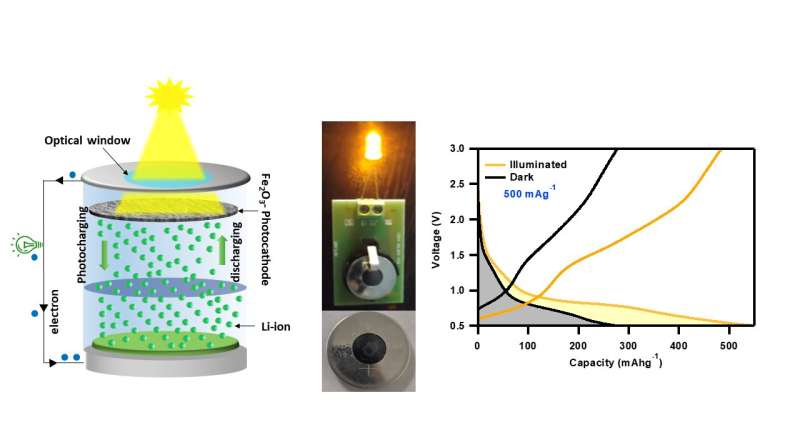Researchers at the Indian Institute of Technology Jodhpur have shown iron oxide nanorods as low-cost photocathodes for photo rechargeable battery applications.

Solar energy is limited due to its intermittent nature, making it difficult to use for off-grid power supply, IoT devices, and remote sensing. Combining solar cells with batteries is cumbersome and costly, requiring separate packaging and more electrodes. Photovoltaic (PV) panels and batteries use different energy materials, which makes the overall system bulky, limiting applications.
Researchers at the Advanced Energy Materials Lab, Department of Physics at the Indian Institute of Technology Jodhpur have demonstrated that iron oxide (also known as hematite) nanorods can be low-cost photocathodes for photo rechargeable battery (PRB) applications.
Light-induced conversion mechanism for PRBs
Iron oxide nanorods can capture visible solar radiation and store Li-ions effectively due to their 2.1 eV bandgap. The study proves standalone photocharging by utilizing the conversion reaction mechanism and achieving over 90% increase in the specific capacity of the Li-ion battery under solar illumination. Nanoporous photocathodes made of hematite, C-61 carbon (PCBM), and carbon nanotubes are produced. Hematite absorbs sunlight and creates photogenerated charge carriers, while PCBM and carbon nanotubes act as conductive additives and provide a pathway for photogenerated electrons to reach the current collector and begin photo charging. To assemble the PRB, a modified 2032 coin cell casing with an 8 mm diameter hole on the bottom serves as an optical window. It is sealed with a transparent PVC sheet, with the active material photocathode facing the window.
Illuminating the PRB with a 470 nm blue LED led to independent charging, with a photoconversion and storage efficiency (PCSE) of 1.988%, a significant achievement compared to intercalation-based ion storage. At 2,000 mA g-1 under white light LED illumination, specific capacities increased by 92.96%. Light exposure causes Fe2O3 nanorods to generate photogenerated charge carriers at the photocathode due to the absorption of high-energy photons. Conductive additives provide a pathway for photoelectrons to reach the current collector and anode via an external circuit. Fe2O3 photo holes oxidize Fe0 to Fe3+, repelling Li+ toward the Li-metal anode via the electrolyte, reducing Li-ions and photo charging. Electrochemical measurements and 3V LED tests confirm the PRBs’ stability and lack of self-discharge issues.
The researchers believe that PRBs show promise for future energy solutions. Still, extensive research is needed to develop efficient materials and an atomistic-level understanding of the mechanism before it can compete with established Si solar cells and Li-ion battery technology.
Reference : Shubham Chamola et al, High Performance Photorechargeable Li‐Ion Batteries Based on Nanoporous Fe2O3 Photocathodes, Advanced Sustainable Systems (2023). DOI: 10.1002/adsu.202300043







